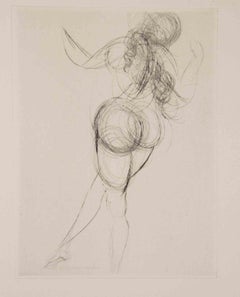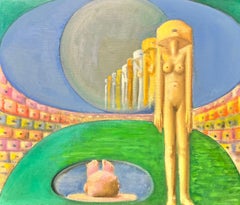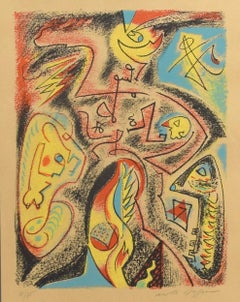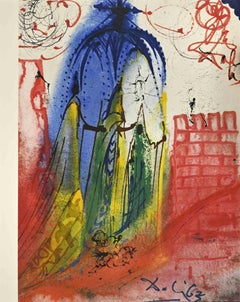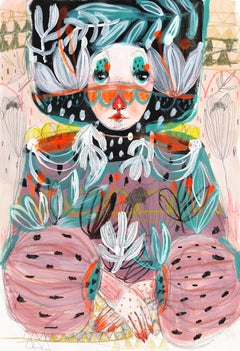Surrealist Art
In the wake of World War I’s ravaging of Europe, artists delved into the unconscious mind to confront and grapple with this reality. Poet and critic André Breton, a leader of the Surrealist movement who authored the 1924 Surrealist Manifesto, called this approach “a violent reaction against the impoverishment and sterility of thought processes that resulted from centuries of rationalism.” Surrealist art emerged in the 1920s with dreamlike and uncanny imagery guided by a variety of techniques such as automatic drawing, which can be likened to a stream of consciousness, to channel psychological experiences.
Although Surrealism was a groundbreaking approach for European art, its practitioners were inspired by Indigenous art and ancient mysticism for reenvisioning how sculptures, paintings, prints, performance art and more could respond to the unsettled world around them.
Surrealist artists were also informed by the Dada movement, which originated in 1916 Zurich and embraced absurdity over the logic that had propelled modernity into violence. Some of the Surrealists had witnessed this firsthand, such as Max Ernst, who served in the trenches during World War I, and Salvador Dalí, whose otherworldly paintings and other work responded to the dawning civil war in Spain.
Other key artists associated with the revolutionary art and literary movement included Man Ray, Joan Miró, René Magritte, Yves Tanguy, Frida Kahlo and Meret Oppenheim, all of whom had a distinct perspective on reimagining reality and freeing the unconscious mind from the conventions and restrictions of rational thought. Pablo Picasso showed some of his works in “La Peinture Surréaliste” — the first collective exhibition of Surrealist painting — which opened at Paris’s Galerie Pierre in November of 1925. (Although Magritte is best known as one of the visual Surrealist movement’s most talented practitioners, his famous 1943 painting, The Fifth Season, can be interpreted as a formal break from Surrealism.)
The outbreak of World War II led many in the movement to flee Europe for the Americas, further spreading Surrealism abroad. Generations of modern and contemporary artists were subsequently influenced by the richly symbolic and unearthly imagery of Surrealism, from Joseph Cornell to Arshile Gorky.
Find a collection of original Surrealist paintings, sculptures, prints and multiples and more art on 1stDibs.
1960s Surrealist Art
Lithograph
1960s Surrealist Art
Etching
1980s Surrealist Art
Canvas, Oil
1970s Surrealist Art
Lithograph
1970s Surrealist Art
Lithograph
2010s Surrealist Art
Paper, Acrylic, Pencil
2010s Surrealist Art
Oil
2010s Surrealist Art
Oil, Panel
1970s Surrealist Art
Paper, Lithograph
1970s Surrealist Art
Engraving
21st Century and Contemporary Surrealist Art
Canvas, Acrylic, Cardboard
Mid-20th Century Surrealist Art
Oil
1960s Surrealist Art
Etching
1960s Surrealist Art
Lithograph
20th Century Surrealist Art
Lithograph
2010s Surrealist Art
Canvas, Acrylic
1950s Surrealist Art
Lithograph
Artist Comments
The artwork depicts the Nine of Pentacles card, symbolizing rapidly growing success, incoming financial satisfaction, and wealth. White bison figures represen...
21st Century and Contemporary Surrealist Art
Oil
2010s Surrealist Art
Digital
1960s Surrealist Art
Etching, Aquatint
21st Century and Contemporary Surrealist Art
Canvas, Charcoal, Mixed Media, Oil, Acrylic
1970s Surrealist Art
Lithograph
1970s Surrealist Art
Etching
1960s Surrealist Art
Lithograph
1960s Surrealist Art
Ceramic
1940s Surrealist Art
Etching
2010s Surrealist Art
Paper, Color
Late 20th Century Surrealist Art
Lithograph
21st Century and Contemporary Surrealist Art
Canvas, Oil
1970s Surrealist Art
Lithograph
Artist Comments
A slow-moving sea turtle swims with determination, balancing a cupcake on its head. It evokes feelings of solitude, peace, and joy. The artwork, painted over ...
21st Century and Contemporary Surrealist Art
Oil
Mid-20th Century Surrealist Art
Oil
Artist Comments
Part of artist Michael Wedge's series explores the contrast between urban and rural environments. This surrealist painting depicts the installation of some digital technology in an unlikely place in nature. A woman prepares to climb up the ladder while another approaches with an open laptop and an extension wire at hand. They are busy in the middle of an open field with a fox wandering between them and deers grazing in the distance.
About the Artist
Michael Wedge works in a variety of mediums: sculpture, painting, mixed media and more. He oftentimes starts with a mental image and creates digital collages, which become the basis for his paintings. A lot of his work references themes from his personal life, such as the experience of living in a city versus in the countryside. If his art seems mysterious, it;s because he enjoys making complex works. "I am attracted to images or moments that seem to have something subtle or hidden under the surface," he explains. When he;s not making art, he teaches it at an elementary school.
Words that describe this painting: surrealism...
21st Century and Contemporary Surrealist Art
Oil
2010s Surrealist Art
Canvas, Oil
Late 20th Century Surrealist Art
Oil
1970s Surrealist Art
Etching
1940s Surrealist Art
Etching
1950s Surrealist Art
Lithograph
1950s Surrealist Art
Lithograph
2010s Surrealist Art
Oil
1970s Surrealist Art
Lithograph
2010s Surrealist Art
Canvas, Acrylic
1970s Surrealist Art
Lithograph
1890s Surrealist Art
Paper
1970s Surrealist Art
Lithograph
21st Century and Contemporary Surrealist Art
Canvas, Acrylic
21st Century and Contemporary Surrealist Art
Canvas, Oil
Ferjo, Fernando de Jesus OliveiraMother (Homage To Whistler), huge original painting on canvas, 2000
20th Century Surrealist Art
Oil
2010s Surrealist Art
Paper, Acrylic, Pencil
1970s Surrealist Art
Lithograph
21st Century and Contemporary Surrealist Art
Canvas, Acrylic
Late 20th Century Surrealist Art
Lithograph
20th Century Surrealist Art
Lithograph
2010s Surrealist Art
Canvas, Mixed Media, Acrylic
1990s Surrealist Art
Lithograph
1970s Surrealist Art
Offset, Lithograph
21st Century and Contemporary Surrealist Art
Canvas, Linen, Oil
2010s Surrealist Art
Canvas, Oil
1940s Surrealist Art
Archival Paper, Engraving, Aquatint, Intaglio
2010s Surrealist Art
Oil
